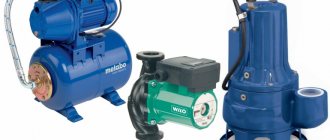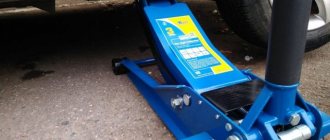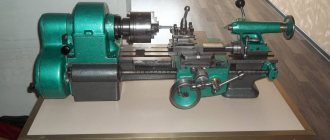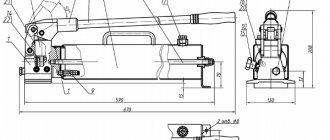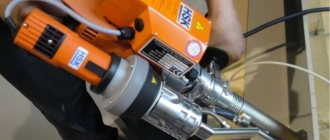- November 21, 2020
- Cars
- Petr Kuznetsov
They say that in Russia there are no roads, but only directions. Sometimes there are not even directions - all around are fields, swamps and impassable mud. You have to figure out the direction yourself. Often, a car gets stuck in the mud, and this applies not only to simple cars, but also to quite serious SUVs - from the Ulyanovsk “goat” to the SUVs used in the NATO army. It's good if there is a winch. What if she’s not there or even she doesn’t help? Don’t leave the “iron horse” to the mercy of fate. But there is one device - a hi-jack, also known as a rack and pinion jack. Not only can he lift your car for a tire change or a detailed inspection. This hi-jack can also be used as a winch.
But not by itself, but with the help of special devices. Such hi-jack kits (they are called Off Road Kits) are sold on specialized Internet sites.
You can also assemble it yourself, it won't be difficult. Some car enthusiasts complain that when used as a hi-jack winch, the main chain cannot withstand it. However, if your goal is not to constantly drive the car deeper into the mud on purpose, and then pull it out of there, but only pull it out, and as rarely as possible, then you can get by with a magazine device.
With hi-jack and...
A manual winch made from a rack jack is a simple device. This device consists of:
- main circuit;
- connecting links;
- chain shorteners;
- shaklov;
- textile sling.
If your task is to participate in competitions, then you can assemble the kit yourself in order to use a hi-jack instead of a winch. It is advisable to buy a chain not even in a fastening store, but in companies that sell rigging products. Its working load should be 4-5 tons. The working load of hooks and shucks is from 1.5 tons.
Main characteristics
There are several types of Hi-Jack jacks. They may differ in size, height, rack travel and the ability to lift different weights.
Jack design:
- hole ruler;
- a lifting mechanism moving in the up and down directions;
- handle;
- a shoe protruding as a support;
- the rail is cast from durable steel.
There are models in various colors. For example, black slats are marked with the number 4 and are made using stamping. Red models are marked with the number 5 and are cast from cast iron. The most durable and effective is a cast iron jack, that is, red.
On a note! Among the special devices, the company produces plastic platforms with which the jack can be used in sand, mud and other types of soil.
The most popular models are designed to lift about three tons of weight. They have the following characteristics:
- Load capacity - 3 tons.
- The rack travel is 700-1350 millimeters, depending on the selected model.
- The pick-up height is 155 millimeters.
- The height of the pick-up from the bottom is 155 millimeters.
- Weight - 13.3-16.9 kilograms, depending on the length of the rack stroke.
Give me a foothold!
Archimedes also said that if he is given a fulcrum, he will move the Earth. To use a hi-jack instead of a winch, you need to attach it to some kind of mount on the ground. In the field, this is most often a tree trunk, although it could also be a stone, a slab, or a concrete block that somehow got in your way.
If there are no trees, stumps or stones, a spare tire will come to the rescue. It can be attached to uneven terrain (for example, in a hole or on a mound with old roots), and best of all, on some bushes (of course, not listed in the Red Book). The main thing is that the structure can withstand the weight of the car and the thrust of the hi-jack. The spare wheel is put on these bushes with the holes in the disk - and the replacement tree is ready.
Which to choose
When purchasing, first of all, you need to decide on the brand and dimensions of the device. Which one to choose? There are many manufacturers of rack jacks. But if you want to purchase a truly high-quality and reliable tool, then you will not find a better jack from the American company Hi Lift. This company has been producing rack and pinion jacks for over a hundred years, and their products are used by the most avid Jeepers.
Hi-Jacks are available in only two colors - black and red. They are made of high-strength cast iron and have several steel parts. Such jacks are considered the standard of reliability and quality. They cost, of course, a little more than models from other manufacturers, but they fully justify their price. At least modifications longer than 150 centimeters do not bend, unlike tools from Chinese manufacturers. By the name of the model you can determine its length. Thus, the Hi-Lift Jack HL-485 has a length of 48.5 inches (120 centimeters), and the HL-605 has a length of 60.5 inches (150 centimeters). These are the models that are most popular among off-road enthusiasts.
Important: When buying a jack, think about how you will transport it, because a one and a half meter tool will not fit into every trunk. Therefore, most likely, you will have to equip your car with a special external mount.
It's not just a ship that needs an anchor
Don’t forget about securing the car itself in place so that it doesn’t fall back when using the hi-jack as a winch, and making the path forward easier, or rather to where you are going to pull it. To do this, if possible, you should place boards, branches, bricks (without piercing or cutting fragments) under the wheels. This needs to be done both when starting to hi-jack and after you have pulled the car out a little. The support is placed under the rear wheels. It is also possible under the front ones, if it does not further interfere with movement when starting off. All manipulations will make it much easier for you to use the hi-jack as a winch. These procedures must be carried out not only at the beginning of the process, but also as it progresses - depending on the situation. In addition, when running a hi-jack, there are often cases when the car is pulled not forward, but up and sideways or even backwards. Then the emphasis of the machine must be adjusted according to the situation.
Application area
A rack and pinion jack is a multifunctional device, because a vehicle can be lifted in four ways. In addition, the device can replace a winch, clamp and even a press. Let's consider all the options for using the tool in more detail.
Lifting the machine by the power parts
Place the jack on a solid surface before lifting the machine.
Jacking up a car by reinforced protruding elements such as sills and bumpers is, of course, the most obvious way to use a rack and pinion “comrade”. So, you can get the vehicle out of a deep and muddy rut or lift the front of the car, thereby simplifying the winch’s task.
Wheel lift
If your car is not equipped with reinforced structures, then a special accessory called Lift Mate, which is often included with the lift, will help you pull it out of any substance. This device is put on the “beak” of the lift and clings to the wheel rim with hooks hanging on rag slings. After this, the ascent is performed.
Special slings are used to lift the car by the wheel.
Helpful Hint: If the Lift Mate was not originally included with the jack, it can be purchased separately. In this case, you should give preference to accessories with rubberized hooks.
Jacking up the bumper
The device is suitable for almost all metal bumpers, under which it is impossible to install a jack “beak”
There are situations when to replace a damaged wheel you need to lift the car by the bumper. But what to do if the latter is not able to withstand the weight of the car. In this case, another additional device will help you out - Bumper Lift. This device is a chain sling with an attachment to the “beak” of the jack and one powerful hook that can be used to grab the power elements under the bumper (frame, axles, etc.).
Helpful Hint: When purchasing a Bumper Lift, pay attention to its maximum load capacity.
Jack as a winch replacement
As noted earlier, the operation of rack and pinion tools is not limited to lifting vehicles and other heavy loads. Hi Jack can also be used as a hand winch. Sometimes, in order to free your “iron horse” from snow or mud captivity, you need to move it less than half a meter. And the capabilities of a rack and pinion jack are quite enough to solve such problems. Moreover, the lift can be placed in the most convenient place, in front or behind the car, and then push or pull the car in the desired direction.
With a swift jack
Assemble the device as indicated in the instructions. Then attach it with a sling to a tree and a chain to the car. It is possible and vice versa, if there is a possibility of rigid fixation. Make sure that the structure is taut and does not sag. This applies to both the sling and the chain. And start using the lever, as when jacking up. The rack moves, and behind it the car returns to active life. It’s very good if a friend sits behind the wheel, works the accelerator pedal, and does it wisely. If you have comrades pushing your iron horse from behind, that’s also good, but in the mud there is usually no such opportunity, and you must not forget where you are pushing the car. Act according to the situation.
How does he work?
As a matter of wisdom, there is only one shutter switch on the mechanism.
Switch up - you can lift it by swinging the lever handle. The “fingers” click on the mechanism, rising through the holes of the rack as if on steps, and the machine rises.
We lower the switch down, swing the lever again in the same way, step by step, the car goes down.
If nothing is jammed in the jack (paint, dirt), then without load the mechanism should slide in the direction of work.
That is, we turn on the lift, place the jack under the bumper and use the handle to lift the mechanism until the “beak” contacts the bumper and only now begin to pump. The same thing happens when lowering: as soon as the load disappears, the mechanism should go down.
Why are additional chains needed?
When you pull the car out of the mud captivity, it travels a certain distance by inertia, moreover, than the distance by which you moved the rack. The chain sags, and the shorteners fasten it with hooks along the sagging area, and the tension returns. In this case, it is desirable to have not one such shortener, but several. Or, for example, you moved the car approximately the length of the rack, but this is not enough. What should I do? Secure the car firmly to the rear and put the handbrake on. Then, carefully and according to all the rules, as written in the instructions for using this device as a jack, return the hi-jack lever to its original position. It is extremely important to use all safety precautions, and first of all, do not place your head and other parts of the body along the path of movement of the handle. Shorten the chain, remove the handbrake from the car, and start working again.
Mechanical rack and pinion jack - lift 5 tons by a meter with your own hands!
Selecting and calculating a rack jack is almost like choosing a parachute for a paratrooper! The safety of the worker, the speed of work, and the ability of the builder to solve many problems without the involvement of lifting equipment often depend on this device. What characteristics should a device have so that you can be 100% confident in your choice?
- Load capacity is the main indicator of any jack, characterizing the maximum weight that the device can lift. Traditionally expressed in tons or kilograms.
- The support platform is the part of the jack that is responsible for resting the product on the ground. It is important that it meets two requirements - it does not slide to the sides and ensures minimal subsidence of the tool into the ground with maximum load capacity. Both the first and second are ensured by the shape of the site.
- Pickup - this part of the jack is designed to support the material being lifted. The pickup can look like a folding rod (most often in rack and screw models), and like a bracket, which is also called a lifting heel (rhombic, hydraulic).
- The initial height of the pick-up is the distance from the support platform to the pick-up, which is inherent in the tool in the “collapsed” position.
- The greatest lifting height is the distance from the support platform to the pickup at the greatest lift of the load.
- Force relative to the drive handle is the force applied by the operator while lifting the load. This characteristic directly depends on the possible mass of the load, which is permissible for a particular mechanism.
- Stability - basically, the characteristic depends on the supporting “heel” of the mechanism and on how tightly it is connected to other parts of the product. This parameter plays a big role when the load, under the influence of certain forces, tries to slip or move.
- Versatility – the ability to use the jack in any situation, with any load.
Hi-jack vs winch
The best option, of course, is the one when you have all the necessary auto devices, while they take up little space, and are also cheap and reliable. For obvious reasons, this is unattainable.
A hi-jack is not a winch or even an ordinary jack in the full sense of the word. In fact, this is a universal thing for jeepers and just people who drive off-road. It serves as a kind of lifesaver for them. That is, he can jack up, and successfully, but only by the wheel or by the power threshold. It can also work with a hand winch, pulling it out of almost any mud, but according to a rather complex and branched algorithm. At the same time, it can work in both modes in any puddle. The winch, it would seem, is easier to operate, but, firstly, it is rare that any will withstand Russian mud, and secondly, dissolving a manual winch under a load is quite a complicated matter.
A simple jack is more versatile and can lift a car without any additional equipment. But he often becomes helpless on country roads or the lack thereof. A hi-jack with a special platform (instead you can use a reliable support like a board or brick) can help in this regard as well. Moreover, if one of your friends has a winch, then even the process of winching with this device can be greatly simplified when the car is additionally pulled out with a hi-jack.
In addition, this device is very unpretentious. After it has been removed from the mud, the hi-jack only needs to be rinsed with water. Additional lubrication may even harm it. It's best to spray it with a little WD-40.
Design features of the rack jack
Among the large selection of car jacks, rack and pinion designs are the most popular. A characteristic feature of the design is the end of the rail, which is bent 90 degrees. Thanks to this, the motorist can easily lift a low-slung car.
The concept of a rack and pinion jack
The advantage of rack and pinion jacks is that they can move loads both vertically and horizontally. At the same time, lifting and lowering the load occurs without much effort.
Another distinctive feature of rack and pinion devices is the low pick-up. Thanks to this, you can lift a vehicle that is practically lying on the ground.
But the design also has its drawbacks. The unit, which can lift a load of up to 5 tons, will weigh about 40 kg. In addition, it is inconvenient and large in size.
Depending on the weight of the load, the designs can be single-stage, two-stage or three-stage.
How to use the device
Climbing according to all rules
Before using the jack, you need to place the car on a flat, horizontal surface. If trouble happens on the road and you can get off the highway, find a safe place with minimal traffic. Switch the gearbox to the appropriate mode: automatic – to “Park” mode, manual – to reverse or forward gear, applying the handbrake. If you are replacing brake drums or the rear wheel, you do not need to use the handbrake. In this case, you need to secure the front wheels with shoes. In general, wheel fixation is required when performing any work. The wheels located in the part of the body opposite to the jack installation are locked.
Now let's talk about where to install the jack itself. It is clear that the device is located in that part of the car body that needs to be lifted. But here you need to be careful: do not fix it in the location of parts that may become deformed. It is recommended to place emphasis on the front suspension beam or the rear wheel axle. For each car model, the manufacturer provides standard installation locations. You can find out about them in the vehicle registration certificate. Proper placement of the jack will help prevent damage to the vehicle.
It is important to know! It is not recommended to lift cars with a plastic body kit using rack and pinion jacks, as the bumper can be damaged and lifting will not be possible. In this case, a pneumatic or rolling model is suitable, which will act directly on the bottom of the car.
The surface under the jack must be flat and hard so that its base does not sink into the ground under the heavy weight. This is especially true for rack and pinion models, popularly called “hi-jacks”. Having a large lifting height, they are not stable, since they have a vertical design and one support point. If the car is stuck in the mud, you need to place a special “off-road” support or a regular board under the jack . This will help create the stability needed to lift the vehicle safely. An exception is inflatable jacks, which can be installed on almost any surface, since when inflated they evenly take the weight of the lifted part of the body over a large supporting area, and not at one point.
Different types of jacks are activated in different ways: mechanical - by pressing a lever or rotating a handle, pneumatic - by the force of compressed air supplied from a compressor, air - from the exhaust gases of a car. When working with all these devices, it is important to remember that you need to lift the car smoothly , while controlling the force and speed of pressing the lever or the intensity of the air supply. This will help avoid sudden lifting and damage to the body. You will find a more detailed algorithm of actions when raising/lowering a car in the instructions for your jack.
Remember that the jack only lifts the car, but does not support it during maintenance. To protect yourself, secure the car with special blocks or supports . It is better to always carry these devices in the trunk so that troubles on the road do not force you to look for replacements. When placing stones or bricks under a car, you cannot be completely sure of the reliability of such a structure. But it happens that there are no other options, and you have to resort to such measures. In this case, before lying under the car, make sure that it does not wobble by rocking the body and, if necessary, strengthen the supports. Competent actions at this stage will guarantee your safety and help avoid injury.
Caring for a rack and pinion lift
As mentioned above, the rack and pinion lift does not require special care. After completing the work, you can wipe off the dirt or rinse it in a nearby puddle so as not to get the trunk too dirty.
Many people are accustomed to taking proper care of such devices, so they maintain their longevity by thoroughly cleaning and lubricating them with machine oil. Oil will only cause harm to a rack and pinion jack, as it attracts excess dust and dirt. Of course, the lift can jam due to debris getting inside the rack. To operate the device, simply pour water over it so that the internal parts can be cleaned.
It is recommended to store hi-jacks on the side of the rails, since the long base will not allow the device to be placed in a different position. In addition, in this position the lift will not interfere with the placement of additional fog lights on the roof rack. It is not advisable to store the jack inside the passenger compartment, as it will contaminate it, not to mention causing difficulties when removing the device.

